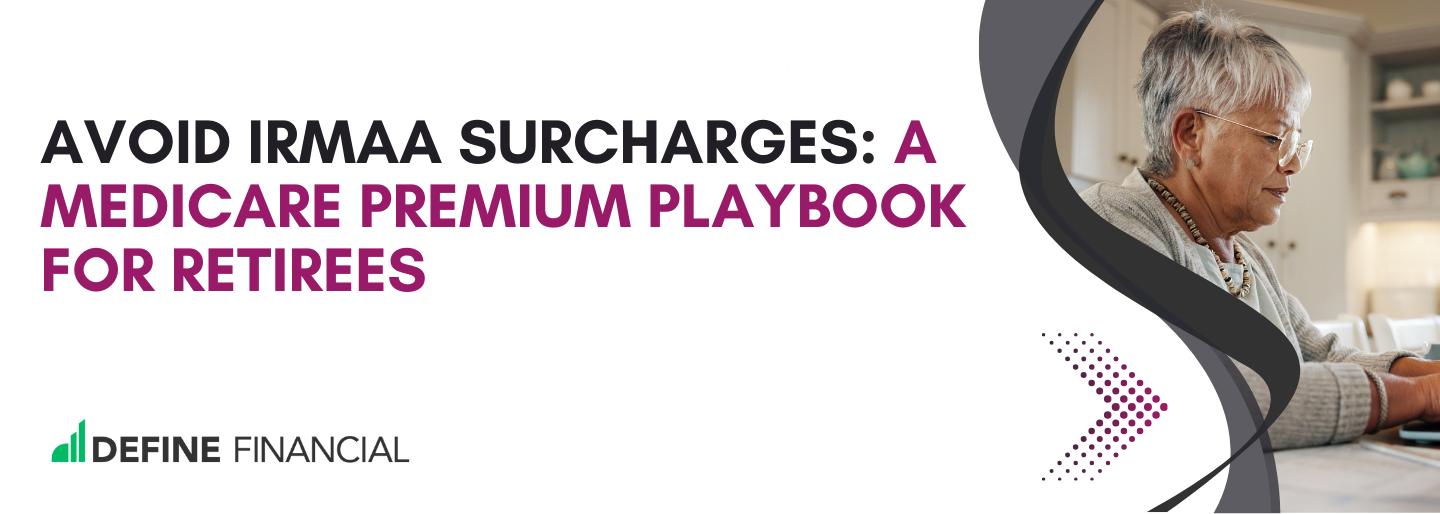
Health care is a line item that rarely shrinks in retirement. Premiums, copays, and prescriptions accumulate over the years, so trimming avoidable costs preserves cash flow.
One lever many retirees overlook sits inside Medicare itself: how your income interacts with premium adjustments.
It’s important to understand how income-related charges work at a high level and why they matter for your plan.
That way, you can see where these added costs come from, why they show up for some people and not others, and how thoughtful income planning can help you keep more of your money for care you actually use.
Key Takeaways
- IRMAA surcharges link Medicare premiums to your modified adjusted gross income (MAGI). Even modest increases can move you into a higher bracket, raising costs for both Part B and Part D.
- You can reduce IRMAA exposure through careful income planning. Strategies include staggering Roth conversions, balancing withdrawals across account types, using HSAs or Roth IRAs, and timing large gains or distributions.
- Certain life events allow you to appeal your IRMAA surcharges. Retirement, divorce, or the death of a spouse may qualify you to file Form SSA-44 so premiums reflect your current income rather than older tax data.
What Is IRMAA and How Does It Work?
When your reported income rises above certain limits, Medicare may tack on an additional cost to your standard premiums. This surcharge is known as the income-related monthly adjustment amount, or IRMAA. It is not a penalty, and it does not apply to everyone. Think of it as a pricing layer Medicare uses to link higher incomes with higher premium costs.
IRMAA can apply to both Medicare Part B and Medicare Part D. Part B covers outpatient care and services, while Part D covers prescription drugs through private plans. When IRMAA applies, you pay the plan’s premium plus an additional income-based amount calculated by Social Security.
IRMAA decisions are based on modified adjusted gross income (MAGI). MAGI begins with your adjusted gross income and then factors in specific additions like tax-exempt interest. Social Security typically looks at the tax return from two years prior when setting the current year’s adjustment (ex: a 2025 decision often relies on your 2023 return).
The adjustment is tiered. Crossing a threshold can move you into a higher bracket, raising the amount you pay for that year. Small shifts near a threshold can have outsized effects, while staying comfortably below a tier can avoid a jump.
Why Retirees Need to Pay Attention to IRMAA
Surcharges stack on top of your base premiums, so the dollars add up over the year. For married couples, the costs can double since IRMAA applies to each spouse individually. Even a single bracket jump can strain a monthly budget that already has housing, travel, and family priorities.
Many routine retirement moves can nudge income higher without much thought. Large IRA withdrawals, one-time capital gains, or selling a property can all raise MAGI in a single calendar year. Those events may be worthwhile, yet the timing can decide whether an adjustment shows up.
Treating IRMAA as part of your income plan helps you make cleaner tradeoffs. You keep flexibility for goals that matter, while choosing when to realize income and when to pull back. That approach can reduce surprises and smooth cash flow year to year.
2025 IRMAA Surcharges at a Glance
If your 2023 tax return pushed your modified adjusted gross income (MAGI) above certain levels, your 2025 Medicare premiums may include extra charges. Here’s what you need to know for quick reference:1
- Base Medicare Part B premium (2025): $185 per month
- Average Medicare Part D premium (2025): $46.50 per month
IRMAA Income Thresholds (Based on 2023 MAGI):
- Single filers ≤ $106,000 / Joint filers ≤ $212,000: No IRMAA surcharges
- $106,001–$133,000 (single) / $212,001–$266,000 (joint): Part B +$74, Part D +$13.70
- $133,001–$167,000 (single) / $266,001–$334,000 (joint): Part B +$185, Part D +$35.30
- $167,001–$200,000 (single) / $334,001–$400,000 (joint): Part B +$295.90, Part D +$57.00
- $200,001–$500,000 (single) / $400,001–$750,000 (joint): Part B +$406.90, Part D +$78.60
- Above $500,000 (single) / $750,000 (joint): Part B +$443.90, Part D +$85.80
If You’re Married Filing Separately:
- >$106,000–$394,000: Part B +$406.90, Part D +$78.60
- ≥$394,000: Part B +$443.90, Part D +$85.80
Key Strategies to Avoid or Reduce IRMAA Surcharges
There is no single switch that turns IRMAA off; however, you can shape your income so that you pay only what you must. The goal is not to chase a bracket at all costs—it’s to find the best after-tax, after-health-care outcome for your household. Here are proven ways to manage exposure without sacrificing your bigger plan:
Manage taxable income carefully: Blend withdrawals across traditional IRAs, Roth accounts, and taxable accounts so no one source pushes you past a threshold. Place interest-heavy holdings in tax-deferred accounts where they fit your mix.
Spread out Roth conversions: Converting in smaller, scheduled amounts can build future tax-free income while moderating current MAGI. Annual guardrails based on your tax bracket and IRMAA tiers help you avoid surprise jumps.
Leverage tax-advantaged accounts: Roth IRAs and health savings accounts (HSAs) add flexibility because qualified Roth withdrawals and HSA payments for medical bills do not increase MAGI. Pre-Medicare households can also build HSA balances during working years to spend tax-free later.
Control timing of income events: Plan big moves, such as selling appreciated positions, exercising options, or taking distributions, during years when other income is lighter. Staggering sales or splitting withdrawals across tax years can keep you below a higher tier.
Consider charitable giving strategies: Qualified charitable distributions (QCDs) from IRAs send dollars directly to charity and exclude the amount from taxable income, which also reduces MAGI. Donor-advised funds can bunch several years of giving into one high-income year while offsetting the tax impact.
Pay attention to Social Security timing: Delaying benefits can lower MAGI in early retirement and create room for conversions or gains. Coordinating start dates with your withdrawal plan makes the most of low-income windows before required minimum distributions (RMDs) begin.
Special Situations Where You May Avoid IRMAA
Some life changes can reduce income quickly, which means last year’s tax return may no longer reflect your situation. When that happens, an IRMAA decision based on old data can be higher than it should be.
Social Security allows an appeal when you experience a qualifying life-changing event, such as retirement, divorce, the death of a spouse, or a significant loss of income. You can ask the agency to use more recent information and recalculate your adjustment.
Please Note: You can request a new IRMAA determination by filing Form SSA-44.2. This form lets you report your updated circumstances and provide supporting documentation. If approved, your IRMMA surcharges will be reduced to reflect your current income rather than the prior tax return.
Practical Examples of IRMAA Triggers
IRMAA charges often stem from reasonable financial moves. The challenge is that timing matters. Even one decision can raise MAGI enough to cross a surcharge threshold. Recognizing these frequent triggers can guide you in choosing whether to spread out, divide, or postpone an action:
Selling real estate or a business: A major sale can create a one-time spike in taxable income. Adjusting the closing date or considering installment-sale treatment can soften the impact.
Taking large IRA or 401(k) withdrawals: Using a lump sum for a remodel, debt payoff, or a large gift may push you into a higher tier. Splitting withdrawals across two calendar years often helps contain MAGI.
Realizing capital gains from investments: Trimming a concentrated stock position or rebalancing a portfolio can increase taxable income. Pairing gains with losses or waiting for a lower-income year can reduce exposure.
Completing a full Roth conversion in one year: Converting everything at once builds long-term tax-free income but may create short-term surcharges. A multiyear conversion plan typically provides a better balance.
Starting pensions or annuity payouts: New guaranteed income streams add to MAGI, reducing flexibility for Roth conversions or other planning moves. Coordinating start dates with your withdrawal strategy keeps options open.
IRMMA FAQs
Does everyone pay IRMAA?
No. IRMAA only applies if your modified adjusted gross income (MAGI) rises above certain thresholds. Many retirees will never pay it if their income stays below those levels.
Can IRMAA surcharges go away once applied?
Yes, they can. IRMAA isn’t permanent. If your income later drops below a threshold, your surcharge will fall back down as well. Moreover, if a drop in income is due to a qualifying life change (like retiring, getting married, divorcing, or losing a spouse), you may ask for an earlier review.
How often are IRMAA brackets updated?
IRMAA brackets are reviewed annually. Each fall, the Social Security Administration publishes the following year’s Medicare premiums and surcharge brackets. These brackets are indexed to inflation, so they can change even if your income stays the same.
Is IRMAA the same as paying higher Medicare premiums in general?
Not exactly. Standard Medicare Part B and Part D premiums apply to everyone who is enrolled. IRMAA is a separate, income-based charge that’s added on top of those base premiums. Your base premium remains the same, but once your income crosses a threshold, you’ll pay an additional monthly surcharge for both Part B and/or Part D.
Can delaying Social Security help with IRMAA?
Yes, in certain situations. By delaying Social Security benefits, you may be able to reduce taxable income in the early years of retirement, giving you more room to manage other income sources like Roth conversions or capital gains.
This window, between when you retire and when you eventually claim Social Security, can often be used strategically to keep MAGI below IRMAA thresholds. However, once you do start benefits, those payments count toward MAGI, so it’s important to coordinate the timing with your overall retirement withdrawal strategy.
How We Can Help You Avoid IRMAA Surcharges
Coordinating Medicare costs with taxes and portfolio withdrawals helps your plan work the way you expect. That starts with mapping out income sources year by year and seeing where IRMAA tiers line up with your goals.
Our approach builds a multiyear withdrawal plan, weighs partial Roth conversions, and schedules big transactions during lower-income windows where possible. You get a clear view of tradeoffs before you act, rather than surprises after the fact.
If you want a second set of eyes on your overall financial picture, please schedule a complimentary consultation. We’ll review your recent returns, run through scenarios that fit your priorities, and craft a premium-aware income plan tailored to you.
Resources:
- https://www.kiplinger.com/retirement/medicare/medicare-premiums-2025-irmaa-for-parts-b-and-d
- https://www.ssa.gov/medicare/lower-irmaa
Taylor Schulte, CFP® is the founder & CEO of Define Financial, a fee-only wealth management firm in San Diego, CA specializing in retirement planning for people over age 50. Schulte is a regular contributor to Kiplinger and his commentary is regularly featured in publications such as The Wall Street Journal, CNBC, Forbes, Bloomberg, and the San Diego Business Journal.



